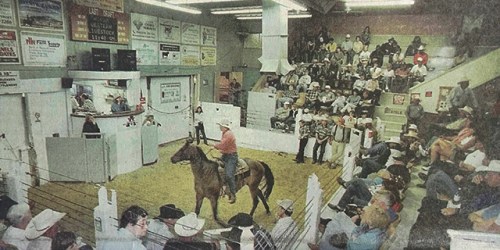East Oregonian Days Gone By
Published 5:00 am Sunday, May 18, 2025

- A rider displays a horse May 20, 2000, during the Hermiston Extravaganza Hose Sale. (East Oregonian, File)
25 years ago this week — 2000
KENNEWICK — A Hermiston man was found guilty of disturbing archaeological resources in Benton County Superior Court on Tuesday.
Steven L. Sawyer, 42, was also found guilty of possession of methamphetamines.
He is scheduled to be sentenced on June 9. Members of the Confederated Tribes of the Umatilla Indian Reservation will likely testify at that time.
Sawyer, along with David L. Bailey of Stanfield, was arrested and lodged in the Benton County Jail on suspicion of violating Indian grave and artifact laws, as well as several drug charges in February 1999.
John Jensen, the chief general prosecuting attorney, said Thursday that the possession of methamphetamines runs a fine of up to 60 days in jail. Disturbing the archaeological site is a misdemeanor punishable by up to 90 days in jail.
Sawyer was found guilty during a “stipulated facts” trial, which requires no jury and is open for appeals. The defense attorney told the media that he plans to appeal the case.
Sawyer and Bailey were allegedly digging up Indian artifacts from Plymouth Island in south Benton County, across the Columbia River from Umatilla. The two suspects were arrested after deputies spotted the pair inside a restricted area near the Plymouth boat launch ramp.
After discovering Sawyer and Bailey were in possession of drugs, deputies searched their vehicle and found evidence of artifact poaching, including several arrowheads, head-mounted flashlights and knee pads.
———
HERMISTON — Beneath Gene Marr’s cowboy hat and behind the yellow-tinted lenses of his glasses are the eyes of a seasoned horse buyer.
The 87-year-old Enterprise resident wears a monocular hanging around his neck so he can zoom in for a better look if he spies a prospect across the stockyard.
Marr has been attending the Hermiston Extravaganza Horse Sale for more than 20 years. At Saturday’s sale, he was the proud owner of three new horses by 10 a.m.
“I bought a bred mare with a colt by her side,” he said. “That’s three horses for the price of one.”
Which brings the total number of horses he owns to how many?
“Oh, let’s not go into that,” he said with a grin.
Marr’s partner on Saturday was Mona Rahn, who is often mistaken as the elder horse broker’s daughter.
“We’re just good friends,” Rahn said. “He’s been my teacher.”
Rahn and Marr were examining a six-year-old palomino mare with a blonde coat that glistened sharply in the morning sun.
“We’re looking for diversity in color,” Rahn said. “Color is definitely a factor in selling a horse. Palominos are very marketable.”
It was a good day to make a trip from Enterprise. Both buyers and sellers agreed Saturday’s auction was a buyer’s market.
———
ADAMS — Larry Coppock’s farm near Adams is an agricultural halfway house.
It’s a place where experimental crops and cropping systems attempt to break out of the rigid disciplines of scientific trials and work their way into the real world of seat-of-your-pants farming.
“What we’re trying to do is blend research at the experiment stations with grower knowledge,” Coppock said Monday afternoon at the beginning of a tour of the “long-term system trials” on his farm.
The outcome of that blending will hopefully be “functioning farming systems” — systems that make money, he said.
The systems approach doesn’t look at just one element of a crop, such as variety, but it looks at how all the elements of a cropping system are working together.
Dale Wilkins, research leader at the U.S.D.A. Agricultural Research Station near Adams, said that the essential elements they look at in evaluating a cropping system are soil erosion, the organic makeup of the soil and the economics of the system.
“Cropping systems need to consider all of these aspects,” Wilkins said. But, he said, there is no specific system that fits every farm. The key is identifying the management options for each individual farm and helping farmers make the best informed choices.
50 years ago this week — 1975
In between worrying about weighty matters like budget crises, state lawmakers are wrestling with a less momentous but irritating issue: the pay toilet.
The argument against pay toilets is linked to the drive for equal rights for women. Opponents of pay toilets argue that women are unfairly handicapped by the locks on booths in public restrooms.
The publication State Government News, issued by the Council of State Governments inLexington, Ky., reported that legislatures in 20 states were considering measures to abolish, or at least restrict, the pay toilet.
Maryland, Minnesota and Wyoming have passed laws against pay toilets. California, Alaska and Florida approved similar legislation last year.
The Wyoming law, which becomes effective May 30, reads: “No person, firm or corporation maintaining toilet facilities generally available to the public shall impose a charge.” Violators face a fine of not more than $100.
Other laws and proposals require that a certain percentage of toilets in public restrooms be free.
A bill to bar pay toilets from state of local government buildings has passes the Nevada assembly and is pending in the senate. Assemblywoman Eileen Brookman, a Las Vegas Democrat, argued for the bull with a rhyme:
“When you have to go, you have to go.
“And when you have to pay dime, it’s a crime.”
———
Voters will be involved in the Umatilla County budgetary process more than ever before, if a proposal by John Hesketh, Umatilla County extension agent, is accepted According to Hesketh’s plan it would be the voters who would decide whether a specific county department could go outside the six per cent limitation.
Currently, the county budget is compiled from the budget requests of the individual departments and then fashioned into an overall budget following review by the county budget committee. If, after the panel’s review, the budget is outside the six per cent limitation, it is submitted to a vote of the people.
Hesketh told the budget committee Tuesday that he favors the formulation of two budgets.
The first would represent the total funding deemed desirable for all departments that would not exceed the six per cent limitation..
The second budget would be the level of funding that the budget committee felt would be appropriate for each department, based upon the assumption that necessary funds would be available. No consideration of a six per cent limit would be given.
If there were a difference between the amount of funding allowed a department in the two budgets, the voters would choose, in a department by department budget election, which level of funding they wished to support.
Hesketh said the additional funding presented in the second budget would not represent the unedited funding requests of department heads, but would be what the budget committee felt most “appropriate, responsible and desirable.”
By placing each department budget that was over six per cent before the voters, Hesketh said, county officials could obtain a reading of What county services were supported by the public and which were not.
———
BOARDMAN – The spring sun slips closer to the southeast Washington foothills across the Columbia River from Board-man.
Long shadows play in the wind, cast from 50-year-old trees which used to provide shade for weary Eastern Oregon travelers.
Sam Boardman’s oasis is still. Only an occasional jack rabbit hops through the barbed wire fence and scoots to the abandoned wellhouse. Wild flowers are the only landscaping.
But a half century ago, the oasis east of Boardman was a busy stopping place. Two such areas provided the only shade between Arlington and Irrigon – developed by Sam Board-man, who settled the area in 1903 and helped form the state park system nearly two decades later.
One rest stop was west of town. It is under water now – flooded by the John Day pool.
The east oasis is still perched on its sandy rise. No travelers stop, though, because the once well-traveled highway is deserted. A traveler today finds himself in the middle of a potato field if he goes too far beyond the quiet park.
Families don’t plan picnics under the shade trees. There are modern, more convenient parks for that purpose.
Only the wind is handy, and miniature sand dunes which spill across fallen tree limbs.
The sun sinks closer to the hills. Another day is about to end. At Sam Boardman’s only remaining oasis tomorrow will be exactly the same.
100 years ago this week — 1925
The increase in insanity is not as great as is commonly supposed, said Dr. W. D. McNary, superintendent of the Eastern Oregon State Hospital, in an address before the Exchange club today. There is some increase due to the faster life people lead these days most people living as much in 50 years these days as they formerly did in 100—but the increased attendance at state hospitals is principally due to the fact methods of treatment have improved to such an extent that people now ask that relatives or friends be treated whereas in years gone by it was not the custom to do this save in extreme cases where the duties of the hospitals were chiefly custodial. At this time approximately 50 per cent of the patients recover and are restored to useful citizenship.
Dr. McNary said that most insanity is due in one way or another to hereditary weaknesses and not to the conditions usually ascribed. These conditions, such as alcoholism or other abuses merely take the patient over the borderline.
According to Dr. MaNary a modern insane institution is far different from what it is supposed to be. Usually a guest at such a place will find no disorder or unusual behavior that may be found in any first class hotel.
During the luncheon today James H. Gwinn, vice president of the club, served as chairman in the absence of President John Secor.
Club members and guests enjoyed a solo and encore by Ray Sprague with Mrs. Sprague serving as accompanist.
———
HEPPNER, Ore., May 21. — Damage estimated at $40,000 was done in Lexington yesterday afternoon between 2 and 3 o’clock when a torrent of water tore down Black Horse Canyon after a cloudburst and inundated the business and residential section of the town. No loss of life was reported, and personal injuries suffered are said to have been slight.
The water that raced down the canyon and through the town ranged in depth from four to six feet, and its force was sufficient to lift buildings from their foundations and move them considerable distances. The office building of the Pacific Telephone & Telegraph company was carried 60 feet on the crest of the flood waters and set down next to a bank building.
The heaviest individual loss is said to have been suffered by the W. F. Barnett general merchandise store. Damage done to the building and stock by mud and water was placed at $15,000. The A. L. Beach store’s damage was placed at $2,000. A harness shop. The post office building and other small buildings were moved from their foundations and damaged.
Trains were delayed last night, and communication wires were out of commission following the flood. The losses by reason of washouts of bridges and stretches of road could not be ascertained. The highway between Heppner and Lexington, a distance of nine miles was almost filled with earth and stones that had washed down the hillsides. Some of the stones weighed several hundred pounds. The highway was not, closed.
———
Prospects are excellent for a good crop of wheat in Umatilla county this year, according to Fred Bennion, county agent. The rain that fell this week over the county came at a time when it did much good all over the wheat belt and was particularly effective in the marginal land districts where grain was beginning to show the effects of dry weather.
About 35,000 acres of Hard Federation is headed out, and a good crop from this variety seems practically assured if the weather holds seasonable. The Hard Federation was largely seeded in the districts to the southwest and northwest of Pendleton for several miles.
The Federation acreage amounts to about 75,000 acres, and this variety, while later than the Hard Federation, is in a condition to make an excellent record for both quality and yield if its future development keeps pace with its growth during the past four or five weeks. All varieties have done well under the prevailing conditions, according to the county agent, and a continuance of the present cool moist weather for another 30 days will insure good yields of the later varieties such as Jenkins and Red Chaff.
Many calls have recently been made to the office of the county agents by farmers who are growing one of the Federation wheat for the first time this year. The inquiry made by the growers is whether some disease has attacked the plants.
“The distinguishing characteristic of the Federation plants,” Mr. Bennion said, “is the whorling leaf. Many farmers do not know this, and they have become alarmed in some cases and are calling to find out what the trouble is. It is as natural for Federation leaves to be curly as for the hair on some peoples’ heads to be curly.”





